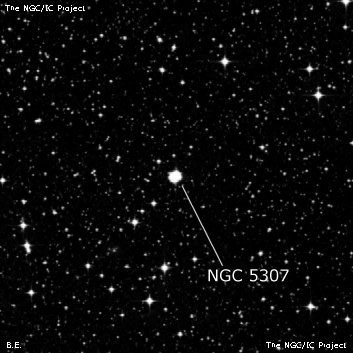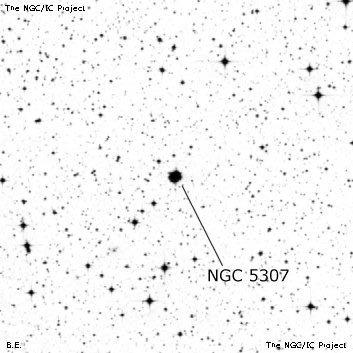NGC/IC Project Restoration Effort
(This is a very very beta version)
NGC5307


Basic Information
Location and Magnitude
Right Ascension: 13:51:3.3
Declination: -51:12:19
Constellation: CEN
Visual Magnitude: 11.2
Historic Information
Discoverer: Herschel J.
Year of discovery: 1836
Discovery aperture: 18.3
Observational
Summary description: planetary, or vF, eS, D neb
Sub-type: PN
Corwin's Notes
=====
NGC 5307, a planetary nebula, was described by JH as double. This is really
quite a remarkable observation because the object is very small and must have
been difficult to resolve. JH calls the night on which he found the nebula
"superb", but it still would have taken quite a careful observer to pick it
up, let alone resolve it.
The DSS2 IR image shows how the object might have looked double to JH, while
the Hubble Space Telescope images (just search for "NGC 5307" on the web) give
us a modern, high-resolution, view.
Purely out of curiosity, I've found positions for the central star and the two
main lobes of the nebula. The central star is the one to take for the entire
NGC object, of course.
Steve's Notes
=====
NGC 5307
18" (7/5/05 - Magellan Observatory, Australia): fairly bright, small, blue-green oval, ~15"x10". This unusual planetary has an irregular, wispy surface brightness with fascinating glimpses of structure at 293x and 428x. It appears brighter along the major axis, particularly at the south end with a couple of small, darker areas or regions where the nebulosity is weaker on the sides. A trio of mag 13-14 stars to the southeast is collinear with the planetary. Situated in a fairly rich star field. See Hubble image of bipolar spiral structure at http://imgsrc.hubblesite.org/hu/db/2007/33/images/a/formats/print.jpg
10" (6/29/02 - Bargo, Australia): at 214x and UHC filter, this small, fairly bright planetary appeared as a slightly elongated disc, ~13"x10" in diameter with a high, fairly even surface brightness except for a weak brightening at the center, but no definite central star. Set in a rich star field 45' ENE of globular NGC 5286 and mag 4.7 M Centauri.



